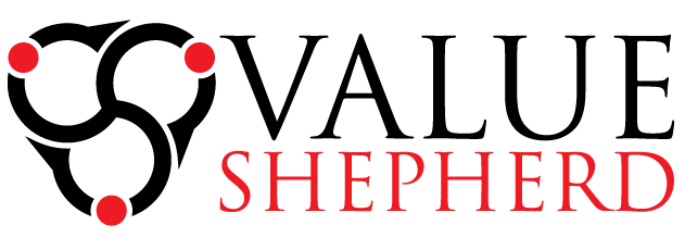At Value Shepherd, we specialize in Business Relationship Management, Digital Transformation, IT Service Management, and Organizational Culture Change.
We recognize that every organization is unique and every consultancy requirement is unique. This page is intended to give you an idea of how we approach consulting.
Click HERE, to find some detailed descriptions of a few common consulting services

At Value Shepherd, we take a personalized and agile approach to consulting, recognizing the unique needs and dynamics of each organization we work with. Specializing in Business Relationship Management, Digital Transformation, IT Service Management, and Organizational Culture Change, we understand that success lies in tailoring our services to meet the specific requirements of our clients.
Our consulting approach is structured around five fundamental steps:
-
Statement of Work / Proposal: We begin by clearly defining the scope and objectives of the project, ensuring alignment with our client's goals and expectations.
-
Discovery / Assessment: Through thorough analysis and assessment, we gain insights into the current state of our client's organization, identifying strengths, weaknesses, and opportunities for improvement.
-
Solutioning: Leveraging our expertise and collaborative approach, we develop customized solutions that address our client's unique challenges and objectives.
-
Implementation: With a focus on execution excellence, we work closely with our clients to implement the agreed-upon solutions, ensuring smooth integration and minimal disruption to operations.
-
Continual Improvement: Our commitment to excellence extends beyond project completion. We empower our clients with the tools, knowledge, and processes needed to independently sustain and build upon the improvements achieved, fostering a culture of continuous growth and success within their organization
Throughout each phase, we emphasize clear communication, measurable deliverables, and a shared commitment to quality and value. By partnering with Value Shepherd, organizations can navigate complex challenges with confidence, achieving sustainable growth and success in an ever-evolving business landscape.”
Explore below for more information:
The VSI Consulting Approach
Phase Objective: Develop a clear Statement of Work (SOW).
Phase Principle: “Clarity creates common purpose and optimized value”
Phase Outcomes:
- SOW (Clearly defined assessment phase, detailed estimates for all other phases)
- Proposal
- Contract
Phase Completion: Agreed SOW and agreement to move forward
Phase Objective: Assess the Current State
Phase Principle: “You need a solid foundation to build a monument”
Phase Outcomes:
- Conducted Assessment (As outlined in the SOW). Assessment types will depend on the scope of the Consulting Engagement. It can include, BRM Maturity, BRM Capability, Demand Maturity, Competency, ITSM Capability, Business Capability, Culture, Governance, etc.
- Delivery of Assessment Report: The assessment report will include quantified results and will identify Strengths, Weaknesses, Opportunities, and Threats. Clear Consultant Recommendations will be included. The Assessment report can be in a simple presentation format or a detailed formal report. The scope of which will be identified in the SOW.
- Draft Roadmap and Refined Statement of Work
Phase Completion: Accepted Assessment Report and agreement to move forward
Phase Objective: Develop The Solution
Phase Principle: “Value Shepherd is not building the solution. The customer is building the solution with our guidance”
Phase Outcomes:
- Develop Roadmap: Solutioning typically begins with the development of a formal / agreed roadmap. This serves to alighn key stakeholders priorities and reduce resistance within the organization.
- Stakeholder Mapping: Ownership assigned for the capabilities within scope. Program and Sustainment Governance determined
- Training / Education: Certification as required. Potential Simulations
- Communication Planning
- Collaborative Development: of future state processes, practices and operating models.
- Rollout Strategy:
- Coaching and Mentoring: as required.
Phase Completion: This phase is often iterative with the “Implementation” phase. Typical completion is triggered by: Approved – Processes, Practices and Governance and Operating Models as well as Agreement to Implement.
Phase Objective: Implement The Solution
Phase Principle: “Holistic Implementation! Practices, Process, Skills, Governance – EVERYTHING it takes for the solution to deliver the desired outcomes “
Phase Outcomes:
- Rollout Strategy Execution: As defined in the Roadmap and the Rollout Strategy developed during solutions
- Communication Management:
- Training / Coaching: Key Stakeholder – Skills Development in “desired State” practices
- Risk Management
- Value Management
- Culture Change
- Evaluation of solution scalability and definition of measurable KPIs
- Sustainment measurements defined
- Celebration of Milestone completion
Phase Completion: This phase is often iterative with the “Solutioning” phase. Typical completion is triggered by: Delivery of the work products defined in the “Refined Statement of Work”
Phase Objective: Empowering Organizations for Sustained Enhancement
Phase Principle: “Evolving Excellence Through Continuous Learning and Adaptation”
Phase Outcomes:
- Empowerment Transition: Transitioning towards organizational self-sufficiency in sustaining and enhancing implemented capabilities.
- Targeted Coaching Sessions: Delivery of remote coaching sessions tailored to reinforce skills, apply learning in real-world contexts, resolve challenges, cultivate adaptability, and foster continuous learning.
- Metrics and Performance Tracking: Establishing metrics and mechanisms for tracking performance to ensure ongoing improvement and effectiveness.
- Feedback Integration: Integrating feedback loops to capture insights, address concerns, and refine approaches for continual enhancement.
- Documentation and Best Practices: Providing comprehensive documentation and sharing best practices to support ongoing learning and optimization.
- Self-Sufficiency Transition: Facilitating the transition towards self-sufficiency by equipping stakeholders with the knowledge, tools, and resources needed for independent capability enhancement.
Phase Completion: Completion of this phase marks the transition to a state of ongoing improvement and self-sufficiency, where the organization is empowered to continually evolve and optimize its capabilities.
